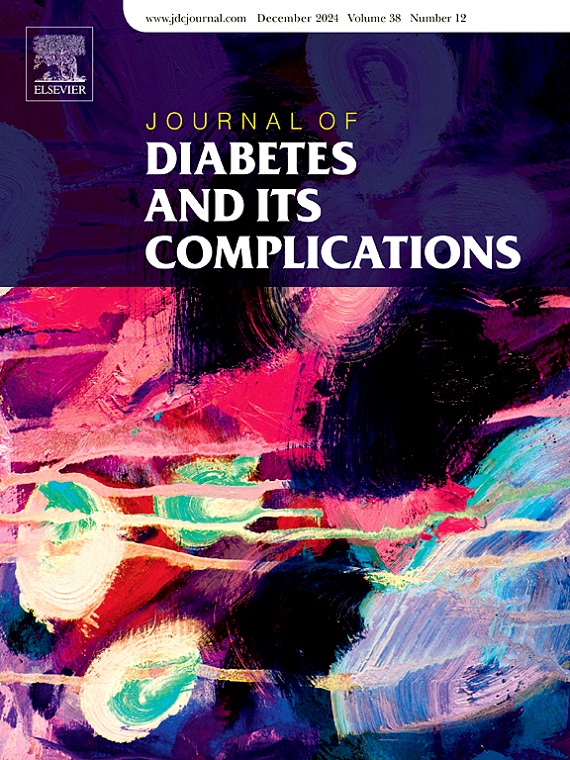血糖变异性对伴有或不伴有糖尿病的心源性休克患者28天预后的影响:一项回顾性队列研究
IF 3.1
3区 医学
Q3 ENDOCRINOLOGY & METABOLISM
引用次数: 0
摘要
血糖变异性(GV)可能反映血糖的急剧上升和急性波动,这与不良心血管事件有关。本研究的目的是探讨GV对合并或不合并糖尿病(DM)的心源性休克(CS)患者28天预后的影响。方法:本回顾性队列研究遵循RECORD(使用观察性常规收集数据进行的研究报告)指南。我们使用重症监护医学信息市场IV (MIMIC-IV)数据库中的临床数据。采用血糖水平变异系数评价GV,根据GV分位数(GV1、GV2和GV3)将患者分为3组,以28天预后为主要指标,机械通气状态、住院时间和ICU住院时间为次要指标,进行统计学分析。结果从MIMIC-IV数据库中共纳入1091例CS患者,其中男性409例(37.49%),女性682例(62.51%)。根据GV水平分为GV1组(< 16.2%, n = 318)、GV2组(16.2% - 25.3%,n = 388)、GV3组(> 25.3%, n = 385)。Kaplan-Meier曲线显示,GV1患者28天预后明显好于GV3患者[220(69.2%)比234 (60.8%),P = 0.044],非dm亚组亦如此[188(73.7%)比108 (61.4%),P = 0.016]。在多因素COX分析中,GV与患者28天死亡风险显著相关[HR 1.42, 95% CI 1.10-1.60, P = 0.012]。在亚组分析中,GV3患者的DM亚组死亡风险最高(HR: 1.53, p = 0.003)。结论:v显著增加CS患者28天死亡风险,尤其是DM患者。未来需要优化血糖监测技术和探索GV调节策略来改善患者预后。关于本研究主题的已知信息:血糖变异性(GV)显著增加心源性休克(CS)患者28天死亡风险。GV水平(16.2% - 25.3%)是糖尿病合并CS患者28天死亡率的独立危险因素,GV (> 25.3%)是非糖尿病合并CS患者28天死亡率的独立危险因素。本研究补充的内容及其未来意义:需要改进更优的葡萄糖监测技术和GV调节策略,以改善患者的预后。本文章由计算机程序翻译,如有差异,请以英文原文为准。
The impact of glycemic variability on the 28-day prognosis of patients with cardiogenic shock with or without diabetes mellitus: A retrospective cohort study
Glycaemic variability (GV) may reflect sharp rises and acute fluctuations in blood glucose, which are associated with adverse cardiovascular events. The aim of this study was to investigate the effect of GV on 28-day outcome in patients with cardiogenic shock (CS) with or without diabetes mellitus (DM).
Methods
This retrospective cohort study adhered to the RECORD (REporting of studies Conducted using Observational Routinely-collected Data) guidelines. We used clinical data from the Medical Information Mart for Intensive Care IV (MIMIC-IV) database. GV was assessed using the coefficient of variation of blood glucose levels and statistically analysed by dividing patients into three groups according to GV tertiles (GV1, GV2 and GV3), with a primary outcome of 28-day prognosis and secondary outcomes of mechanical ventilation status, length of hospital stay and length of ICU stay.
Results
A total of 1091 patients from the MIMIC-IV database with CS were included, of which a total of 409 (37.49 %) were male patients and 682 (62.51 %) were female patients. Based on GV levels, three groups were classified as GV1 (<16.2 %, n = 318), GV2 (16.2 %–25.3 %, n = 388), and GV3 (>25.3 %, n = 385). According to the Kaplan-Meier curves, the 28-day prognosis was significantly better in GV1 patients than in GV3 [220 (69.2 %) vs. 234 (60.8 %), P = 0.044], and the same was true in the Non-DM subgroup [188 (73.7 %) vs. 108 (61.4 %), P = 0.016]. In a multifactorial COX analysis, GV was significantly associated with the risk of 28-day mortality in patients [HR 1.42, 95 % CI 1.10–1.60, P = 0.012]. In the subgroup analyses, the risk of death was highest in the DM subgroup of patients with GV3 (HR: 1.53, p = 0.003).
Conclusion
GV significantly increases the 28-day risk of death in patients with CS, especially in DM patients. Future optimisation of glucose monitoring techniques and exploration of GV modulation strategies are needed to improve patient prognosis.
What is known about this research topic:
Glycaemic variability (GV) significantly increases the 28-day risk of death in patients with cardiogenic shock (CS).
GV level (16.2 %–25.3 %) was an independent risk factor for 28-day mortality in patients with DM and CS, and GV (>25.3 %) was an independent risk factor for 28-day mortality in Non-DM patients with CS.
What this study adds and its future implications:
More optimal glucose monitoring techniques and GV modulation strategies need to be refined to improve patient outcomes.
求助全文
通过发布文献求助,成功后即可免费获取论文全文。
去求助
来源期刊

Journal of diabetes and its complications
医学-内分泌学与代谢
CiteScore
5.90
自引率
3.30%
发文量
153
审稿时长
16 days
期刊介绍:
Journal of Diabetes and Its Complications (JDC) is a journal for health care practitioners and researchers, that publishes original research about the pathogenesis, diagnosis and management of diabetes mellitus and its complications. JDC also publishes articles on physiological and molecular aspects of glucose homeostasis.
The primary purpose of JDC is to act as a source of information usable by diabetes practitioners and researchers to increase their knowledge about mechanisms of diabetes and complications development, and promote better management of people with diabetes who are at risk for those complications.
Manuscripts submitted to JDC can report any aspect of basic, translational or clinical research as well as epidemiology. Topics can range broadly from early prediabetes to late-stage complicated diabetes. Topics relevant to basic/translational reports include pancreatic islet dysfunction and insulin resistance, altered adipose tissue function in diabetes, altered neuronal control of glucose homeostasis and mechanisms of drug action. Topics relevant to diabetic complications include diabetic retinopathy, neuropathy and nephropathy; peripheral vascular disease and coronary heart disease; gastrointestinal disorders, renal failure and impotence; and hypertension and hyperlipidemia.
 求助内容:
求助内容: 应助结果提醒方式:
应助结果提醒方式:


